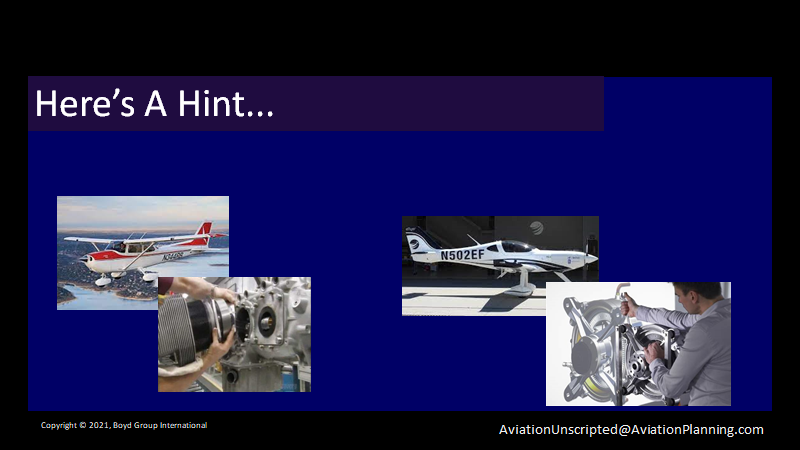The Folks In Washington Are Fixin’ To Reshape Aviation
Planning Starts NOW… Or Should Have Started Long Ago.
It is not another shopworn cliche – aviation in five years won’t look much like it does today. That GA ramp. That fuel farm. That passenger gate. The flying machines using the facility. Different in form, application and economic impact.
That means airport planning has to accept the fact that the role and the user base of airports will change as well.
These changes are not evolutionary. They are going to be episodic, and in some cases based on trendy political dogma, not solid futurist planning. In other cases, new emerging technology will be coming over the airborne transom in the near term.
Take a look at the following slide – one we use with our airport planning clients. It relates to just one of the major disruptions facing airports today, but is emblematic of the future.
A traditional thinker would just see two airplanes. One older, one newer. A futurist thinker would see indications of a complete change in the basic foundations of the airport industry.
See, the plane on the left, a Cessna 172, is indicative of the past. A past that may not hang on for too many more years.
The one on the right, an electric two-seater from Bye Aerospace, is indicative of an impending tsunami in what will be whole new financial demands on airports across the nation, whether it’s JFK International or a rural airport in Nebraska.
It’s just one of many foundational changes, but it is a clear one. Electric aircraft are coming. As we intimated in last week’s Touch & Go newsletter, traditional combustion-powered GA airplanes are going to have a targeted future… a shorter one than most people might think. Don’t sell this one short… if they can ban gasoline lawnmowers in California, recreational general aviation might not be far behind.
That means airports need to anticipate a lot of changes – complete changes – in traditional airport operations. Let’s explore just the surface issues…
Maintenance & Support. These new electric powerplants have nothing in common with the Lycomings on that light twin. But they are machines and they will need maintenance. A traditional A&P training program isn’t going to fit. Conclusions…?
CFR – what about safety and emergency response. A traditional emergency vehicle might have a difficult time extinguishing a battery fire, not to mention the need to train staff in safely approaching and handling such events. We’re talking about enough voltage to kill rescuers in the case of an accident.
While it’s not completely the same situation, there have been fires on Tesla automobiles that took thousands and thousands of gallons of water, using traditional equipment, to extinguish. What would be the case with some of these larger 50-seat electric airplanes already on order? What equipment will be needed – and it isn’t just another traditional rescue vehicle, either.
Battery Recycling. As of today, the expected retirement of used batteries still represents a huge future challenge. Regardless of all the sunshine stuff about battery power, there is a gap in regard to whether there will be sufficient – and environmentally-sound – recycling facilities for lithium ion batteries. Airports across the nation may be able to have a role in this.
Fuel Revenues. As we covered in last week’s Touch & Go newsletter to our friends and clients, the concept of internal combustion anything gets some folks all itchy and nasty.
When some of these trendy people get savvy about what the term “100LL” means, it can turn into the intellectual equivalent of a torch-carrying environmental lynch mob. So, even with conversion to mo-gas and diesel combustion, we can look toward fuel flowage not being a growth revenue stream.
Regulatory Dogma v Intelligent Planning. Heck, we actually are saddled with Secretary of Energy that literally snarled a condescending giggling response when questioned if she had any programs to reduce the cost of gasoline… “Are you kidding?” was the smarmy response. She was also the one that practically welcomed the terrorist attack on the Colonial Pipeline, stating it would encourage the purchase of electric vehicles.
So, let’s stop playing nice-nice and recognize there may be some very inept policies coming down the line from inside the Beltway.
Electrical Power Stations. At some point the concept of having places to plug-in these new aircraft has to come into not just facility planning, but revenue planning as well. A reordering between traditional revenue streams, particularly at high volume GA facilities, is likely going to be necessary, as a plug-in station isn’t likely to bring in the money petro-fuel does.
Opportunities… Not Brick Walls.
What each of these dynamics represent – and they only cover the first pass of changes – is opportunity. The new technologies will require support and new infrastructure. New types of powerplant maintenance. New designs for hangar space and design. New training facility needs.
What every community in America should be doing now – right now – is revisiting its entire airport planning program. These types of opportunities are not restricted to the local user base.
For example, what about the support for electric aircraft? An electric powerplant overhaul facility can attract business from around the nation, for example. Technical training will be needed, too. There will be entirely new training requirements, and schools can be established just about anywhere.
What about rethinking the entire financial basis of the airport? What revenue sources will atrophy, and where are new opportunities based on these expected changes.
We can go on from here. And, by the way, that’s just what we’re doing.
At Boyd Group International, we understand that the entire role of airports as part of the nation’s communication system has changed. Based on this, we’re working to provide clients with what we call Runway To The Future, a program tailored to match an airport’s future planning trajectory with the types of emerging and disruptive technology and consumer trends represented by these and other shifts.
Give us a call, or just click on the contact tab, and we can get a discussion going.
A discussion of the future.
__________________
This Week’s Aviation Unscripted Video –
Air Rage Incidents…
Airlines And Passengers Are On The Same Side
 There are more disgusting occurrences of in-flight air rage than ever before.
There are more disgusting occurrences of in-flight air rage than ever before.
One reason is that consumers are on the raw edge after more than a year of constrictions, rules, dumb political decisions and simply being needled in all areas of their lives, due to the CCP-Wuhan pandemic.
There is no excuse for air rage, but the raw fact is that a lot of consumers are fed up and feeling helpless. Then in the cabin of an airplane, one-on-one with the flight attendants who are only trying to assure that the airline comply, bad stuff happens. Or, being on an emotional edge, lots of incivility between passengers can erupt.
Get the picture? The requirement to wear some membrane – with only a couple of exceptions, any kind of membrane – over one’s face is the main fuse to bad passenger attitudes. It can be a medical mask, an N94, or just one of those (sometimes defective) paper-and-string “masks” imported directly from the place with the government that started this pandemic.
The problem is that now airline staff – particularly flight attendants – are put in the role of enforcing these politically-driven face mandates that were imposed on the airline industry, without any consultation or medical justification. The core of the issue is the misconception (on both sides – passengers and employees) that the mask (really “face-covering”) mandate is an airline industry mandate.
It is not… essentially and actually, airlines and passengers are in the same victim situation of having to adhere to a federal dictum that is invasive, uncomfortable but also political in nature and of questionable value. That last comment – questionable value – is 100% accurate. It  doesn’t take a degree from Johns Hopkins to see that there are no firm standards for what a “face mask” is, or how effective – or ineffective – it might be in any case on an eight hour flight. Passengers know that.
doesn’t take a degree from Johns Hopkins to see that there are no firm standards for what a “face mask” is, or how effective – or ineffective – it might be in any case on an eight hour flight. Passengers know that.
The airline industry is now carrying a different genre of passengers – a lot are fed up with two years of constrictions and impositions of rules from on High. So, when they get into an airplane cabin, the way that the mask mandate is expressed to them can either be just another dictum from what appears to be the feds, or information advising that this requirement is a federal one that the airline and passengers (who actually are on the same side of the victim fence) are required to follow, just as the crew is, too.
Unfortunately, it is typically expressed as just another airline rule, that passengers will follow at risk of being tossed off the airplane. Instead, it should be postured as just what it is – an FAA rule that airlines and passengers need to adhere to. This makes the consumer feel that the airline is fully understanding of the situation.,
Point: airlines must assure that passengers are compliant with this political rule, but they need not – and must not – convey it as part of the carrier’s wonderous program to protect the public. The whole mask thing – again, based on lack of standards of what a mask really is, not to mention how effective it is or isn’t on long flights – is not credible. Sorry if that offends traditional politically-correct obedience, but facts are facts.
It must actively and consistently and openly be expressed as an FAA/fed rule, and not that of the airline itself.
Click here, and join us… and if you have any thoughts or opinions, do let us know!
